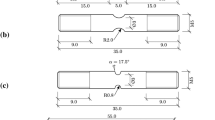Abstract
A study has been conducted to investigate the metallurgical cause of splitting that is sometimes observed to accompany regular fracture in tensile and Charpy impact specimens. The susceptibility of a steel to tensile specimen splitting (TSS) has been shown to depend on both the composition as well as the processing of Cb (Nb) and V bearing high-strength, low-alloy steels. This study has revealed that Fe3C, either as grain boundary precipitate or in pearlite of a particular distribution, was the microstructural feature which seemed to be responsible for the TSS in the steels investigated. The compositional and processing factors influenced the susceptibility of specimens to TSS by controlling the Fe3C precipitation. There was no correlation between the susceptibility of a microstructure to TSS and its short transverse ductility. This result indicates that the occurrence of splitting in broken tensile or impact specimens is neither related to nor a good predictor of the probability of occurrence of the lamellar tearing that may occur during welding. A mechanism is presented which establishes the link between composition, processing, microstructure, splitting susceptibility and short transverse ductility.
Similar content being viewed by others
References
J. C. M. Farrar, R. E. Dolby, and R. G. Baker:Weld. J., 1969, vol. 48, p. 7, (Res. Suppl. 274-S).
J. E. M. Jubb:Welding Research Council Bulletin No. 168, December 1971.
J. C. M. Farrar:Weld J., 1974, vol. 53, p. 8, (Res. Suppl. 321 S).
D. M. Nicholls:Brit. Weld. J., 1968, vol. 15, p. 103.
J. C. M. Farrar, J. A. Charles, and R. E. Dolby:Proceedings of Symposium on Effects of Second Phase Particles on the Mechanical Properties of Steel, p. 171, The Iron and Steel Institute, London, 1971.
J. C. M. Farrar, B. J. Ginn, and R. E. Dolby:International Conference on Welding in Offshore Construction, p. 96, The Welding Institute, London, 1975.
J. M. Hodge, R. H. Frazier, and F. W. Boulger:Trans. TMS-AIME, 1959, vol. 215, p. 745.
A. J. Birkle, R. P. Wei, and G. E. PellissierTrans. Amer. Soc. Metals, 1966, vol. 59, p. 981.
W. Dahl, H. Hengstenberg, and C. Düren:Stahl Eisen, 1966, vol. 86, p. 796.
W. Dahl, H. Hengstenberg, and C. Düren:Stahl Eisen, 1968, vol. 88, p. 643.
G. R. Wilms:J. Aust. Inst. Metals, 1973, vol. 18, p. 47.
I. Kozasu and H. Kubota:Trans. Iron Steel Inst. Jap., 1971, vol. 11, p. 321.
A. J. De Ardo, Jr. and E. G. Hamburg:Proceedings of International Symposium on Sulfides in Steel, p. 309, ASM, Metals Park, Ohio, 1974.
T. J. Baker and J. A. Charles:Proceedings of Symposium on Effect of Second Phase Particles on Mechanical Properties of Steel, p. 79, The Iron and Steel Institute, London, 1971.
G. Bernard, M. Grumbach, and F. Moliex:Metals Technol., 1975, vol. 2, p. 512.
S. Marich: Private communication, Broken Hill Proprietory Co. Ltd., Melbourne Research Laboratories, Clayton, Victoria, September 1974.
D. F. Lentz:Proceedings of Sixteenth Mechanical Working and Steel Processing Conference, p. 397, TMS-AIME, New York, N.Y., 1974.
D. S. Dabkowski, P. J. Konkol, and M. F. Baldy:Metals Eng. Quart., 1976, vol. 16, p. 22.
A. J. DeArdo, Jr.: Unpublished Research, Jones and Laughlin Steel Corporation, Graham Research Laboratory, Pittsburgh, Pa., April 1974.
H. Herø, J. Evensen, and J. D. Embury:Can. Metal. Quart., 1975, vol. 4, p. 117.
A. J. DeArdo, Jr.:Sixteenth Mechanical Working and Steel Processing Conference, p. 119, TMS-AIME, New York, N.Y., 1974.
F. A. McClintock:Ductility, p. 255, ASM, Metals Park, Ohio, 1968.
H. C. Rogers:Ibid., p. 31.
Author information
Authors and Affiliations
Rights and permissions
About this article
Cite this article
DeArdo, A.J. An investigation of the mechanism of splitting which occurs in tensile specimens of high strength low alloy steels. Metall Trans A 8, 473–486 (1977). https://doi.org/10.1007/BF02661759
Received:
Issue Date:
DOI: https://doi.org/10.1007/BF02661759




